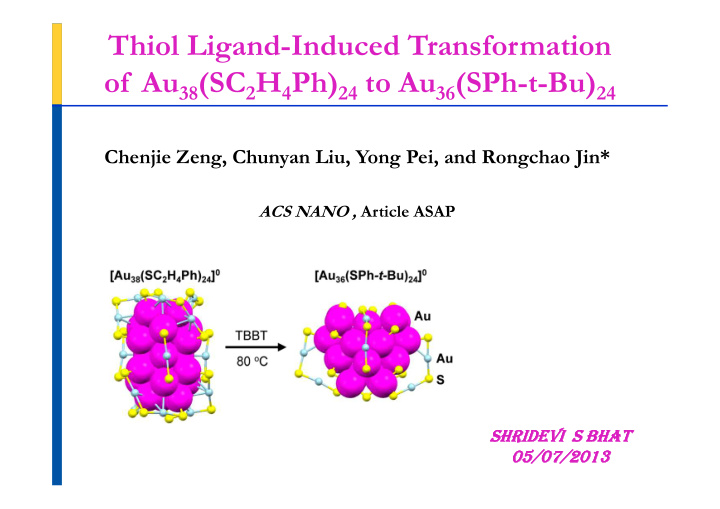



Thiol Ligand-Induced Transformation of Au 38 (SC 2 H 4 Ph) 24 to Au 36 (SPh-t-Bu) 24 Chenjie Zeng, Chunyan Liu, Yong Pei, and Rongchao Jin* ACS NANO , Article ASAP SHRIDEVI S BHAT SHRIDEVI S BHAT SHRIDEVI S BHAT SHRIDEVI S BHAT 05/07/2013 05/07/2013 05/07/2013 05/07/2013
INTRODUCTION � The synthesis of thiolate-protected gold nanoclusters and studies of their properties have achieved significant advances in recent years. � Size-focusing methodology has been successfully established giving rise to molecularly pure Au 25 (SR) 18 , Au 38 (SR) 24 , and 25 18 38 24 Au Au 144 (SR) 60 nanoclusters and bimetal ones as well as some larger (SR) nanoclusters and bimetal ones as well as some larger nanoclusters. � In addition to the size-focusing method, another useful approach pertains to ligand exchange, such as phosphine-to- thiol exchange processes. � However, in many cases molecular purity product could not be obtained except in the case of phosphine-capped Au 11 to thiolate-capped Au 25 .
IN THIS PAPER � An interesting disproportionation mechanism identified in the transformation of Au 38 (PET) 24 to Au 36 (TBBT) 24 is discussed. � The ligand exchange reaction of Au 38 (PET) 24 with bulkier TBBT induces structural distortion of the initial rod-like biicosahedral Au (PET) biicosahedral Au 38 (PET) 24 structure. structure. � This process is evidenced by detailed mass spectrometric and optical spectroscopic analyses. � The optical spectrum of Au 36 (TBBT) 24 was further interpreted by theoretical simulations on a Au 36 (SCH 3 ) 24 model cluster.
Scheme 1: Conversion of Au 38 (PET) 24 to Au 36 (TBBT) 24 nanoclusters (the carbon tails are not shown for clarity; S atoms, yellow; kernel Au atoms, magenta; surface Au atoms, green or cyan).
RESULTS AND DISCUSSION � Stage I: In the first stage (0-5 min), ligand exchange reaction occurs. � Stage II: In this stage (10-15 min), the ligand exchange reaction continues, but it starts to induce structural distortion of the original Au (SR) original Au 38 (SR) 24 cluster, as manifested in the optical spectra. cluster, as manifested in the optical spectra. � Stage III: It is in this critical stage (20-60 min) that the size and structural conversions take place. � Stage IV: During the fourth stage (120-300 min), during which a size focusing conversion occurs together with further ligand exchange toward completion.
(A) Time-dependent ESI-MS of the transformation reaction. The doubly charged region is shown. The three gray shadows indicate three groups of peaks: (left) Au 36 (TBBT) m (PET) 24– m , (middle) Au 38 (TBBT) m (PET) 24– m , (right) Au 40 (TBBT) m+2 (PET) 24– m . The numbers on the top of the mass peaks indicate the number of TBBT ligands ( m ) exchanged onto the cluster. (B) Corresponding UV–vis spectra of different times in parallel with ESI-MS.
Scheme 2: Reaction pathway for conversion of Au 38 (PET) 24 to Au 36 (TBBT) 24 . Stage I, ligand exchange; II, structure distortion; III, disproportionation; IV, size focusing.
E a,II = 107 kJ/mol E a,III = 152 kJ/mol Kinetic curve (monitored by absorbance at 550 nm) for the conversion of Au 38 (PET) 24 to Au 36 (TBBT) 24 at 80 ° ° ° ° C.
Time-dependent UV–vis spectral evolution of 4- tert -butylbenzenethiol with Au 38 (PET) 24 . Time-dependent UV–vis spectral evolution of cyclohexanethiol reaction with Au 38 (PET) 24 .
(A) Comparison of simulated UV–vis absorption spectrum of Au 36 (SR) 24 with the experimental spectrum. (B) Estimation of contributions of Au(6sp), Au(5d), and S(3p) to KS orbitals.
Comparison of the MALDI-MS and ESI-MS spectra of Au 36 (TBBT) 24 . The asterisks indicate the fragments due to MALDI.
CONCLUSION � The detailed mechanism of the ligand-induced conversion from Au 38 (PET) 24 to Au 36 (TBBT) 24 is discussed . � The reaction pathway can be roughly divided into four stages. � This process gave rise to Au 36 nanoclusters in ∼ 90% yield (Au � This process gave rise to Au 36 nanoclusters in ∼ 90% yield (Au atom basis), approaching the theoretical yield of ∼ 94% ∼ according to the disproportionation mechanism. � The conversion of biicosahedral Au 38 structure to fcc Au 36 structure is remarkable; it provides an unprecedented example of ligand bulkiness induced size and structural transformation in thiolate-protected nanoclusters.
SIGNIFICANCE The role of ligand in the formation and crystallization of clusters! Chiral Structure of Thiolate-Protected 28-Gold-Atom Nanocluster Determined by X-ray Crystallography Chenjie Zeng, Tao Li, Anindita Das, Nathaniel L. Rosi, and Rongchao Jin*.
Recommend
More recommend